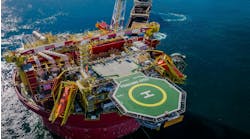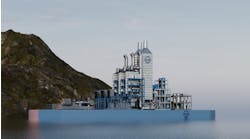First commercial monobore expandable liner installed
Installation of the first monobore expandable liner extension system (MELES) has proven the feasibility of solid expandable tubulars as an alternative to conventional, telescoping casing designs. MELES could enable drilling deeper wells with larger hole sizes at the reservoir, and isolating zones with reactive shales, sub-salt environments, low-fracture-gradient formations, or other such situations, and then drill ahead without having to reduce the casing and subsequent drilled hole size.
MELES was a collaboration between BP and Baker Oil Tools. The linEXX system has undergone four years of full-scale field testing and modification as part of its development. A key non-destructive test (NDT) method, called “enhanced UT” (ultrasonic transmission), was developed to prove the system design. This method performed acceptance and qualification testing of unexpanded 203 mm (8-in.) OD tubes. The field testing also proved the functionality of several running tool modifications and helped refine standard operating practices, and improve running procedures and documentation.
The linEXX system has undergone four years of full-scale field testing and modification as part of its development.
The installation and expansion of 461 m (1,514 ft) of this system was in a commercial BP well. The installation in an air-drilled 314-mm (12 3/8-in.) vertical hole at 1,250-m (4,100-ft) depth.
The ability to reach depth without sacrificing casing size could allow drilling of much deeper or deviated wells. Additionally, the ability to set casing across unexpected problem zones during drilling could allow the producing section of the reservoir to be entered with the initial size diameter production casing to maintain production capability which would be compromised by smaller casing. The potential benefits are significant in high-cost/high-risk offshore operations.
First commercial MELES
The running and installation sequence was as follows:
- The 244 mm (9 5/8-in.) parent casing and recess shoe were run to a depth of 789 m (2,589 ft). The casing then latched and packed off in the surface wellhead. The parent casing string was run but not cemented to allow removal if needed.
- Running and handling procedures similar to those for chrome tubulars were used to run 461 m (1,514 ft) of 203-mm (8-in.) OD unexpanded liner in the hole. Typical make-up torque of 4,300 ft-lbs was verified. After installing the expandable liner hanger/packer, the top-down expansion tool assembly was made up, and the liner was run in the hole on drill pipe. The hanger then was located positively in the recess shoe profile and pressure was used to “stroke” the expansion tool and expand the hanger into the shoe.
- The liner was expanded 18% to 219 mm (8 5/8-in.) nominal ID and 216 mm (8 1⁄2 in.) drift I.D. in 4 1⁄4 m (14 ft) increments by applying drill pipe pressure to the expansion tool and then de-pressuring and slacking off to re-cock the tool until the entire 461-m (1,514-ft) length was expanded. The expansion process was completed as planned using a truck-mounted cement pump to supply expansion pressure.
- The expansion assembly was retrieved, and post-expansion drift was then verified by two independent methods: (1) a drift run directly to bottom with a stiff three-point contact drilling assembly to provide mechanical assurance, followed by (2) a caliper logging tool run which provided digital data to support the mechanical method. These verifications confirmed the ability to deliver a well with 216 mm (8 1⁄2-in.) drift per the operator’s request.
- A cement retainer was run in hole and set near the bottom of the expanded liner, and the liner was cemented in place using the same pump truck that had supplied expansion pressure. Cement volume was selected to ensure that the planned formation integrity test would be achieved without taking cement returns into the 244 m (9 5/8-in.) casing through the recess shoe ports (contingency plan). Because top-down expansion allows cement to be pumped after expansion, no changes were required to the cement thickening time.
- After successfully pressure testing the expanded liner, the retainer and excess cement were drilled out. Drilling then continued below the recess shoe with rotary steerable directional tools. The system was isolated with the production casing before completing the well.
The system
This system is a solid expandable tubular product that accommodates expandable liner lengths up to 914 m (3,000 ft) in 244 mm (9 5/8-in.) or 251 mm (9 7/8-in.) casing and consists of five primary components:
- 1. The system expandable solid casing
- 2. RC9 series recess casing shoe
- 3. FORMlock expandable liner hanger/packer
- 4. RNX retrievable guide shoe
- 5. catEXX top-down expansion system.
The recess shoe is installed with the “parent” casing string to positively locate the expandable liner in the parent string. Its recess ID and location profile enable the liner to anchor on the bottom of the parent casing and then to expand into the shoe with no ID size restriction below the parent casing. This distinguishes this expandable liner system from those with an ID size restriction from hanging off in the parent casing. It is available in two versions: one that facilitates cement circulation, and one that does not.
The expandable liner hanger/packer is in the recess shoe and ties the expandable casing to the previous casing string. The system is run below the liner hanger/packer and expanded to 216 mm (8 1⁄2-in.) ID drift. Pre-expanded casing OD is 203 mm (8 in.). The guide shoe is installed at the bottom of the expandable string to guide the liner in the hole.
Expansion occurs from the top down and relies on pressure in the drill pipe to expand the liner. The top-down expansion addresses the risk of not being able to retrieve the expansion cone as a result of catastrophic loss of expansion pressure. The design does not rely on drill pipe set-down weight or overpull, nor does it apply expansion pressure to the expandable casing or rely on a dart sealing process to assure pressure integrity during expansion.
An anchor, hydraulic cylinder and expansion cone comprise the expansion assembly. As pumping begins, slips extend from the anchor to lock the expansion assembly in place. Continued application of pressure through the workstring extends the hydraulic cylinder and moves the cone downhole in 4 1⁄4 m (14 ft) incremental stroke lengths.
The top-down expansion method allows incorporation of a retrieval collet onto the bottom of the expansion assembly, which makes it possible to retrieve the guide shoe and leave an open ID through the entire length of the liner when it is fully expanded. Typical expansion rates are 30 m (100 ft) per hour.
Mass is conserved during expansion. Wall thickness thins only slightly, while the length shrinks 4%. Because the expansion is top-down and shrinkage occurs at the “free” end of the system, a portion of the open hole at TD will be left uncased. As a result, a rat hole must be drilled below the specifically targeted trouble zone being isolated as is done in typical liner setting applications. The system is applicable to the majority of standard drilling hazards.
North Sea recess shoe applications
The installation of the RC9 series recess shoes on 244-mm (9 5/8-in.) casing strings in four North Sea wells set the stage for future contingency applications of monobore expandable liner extension technology. The wells were in Statoil’s Kristin and Kvitebjørn high pressure/high temperature (HP/HT) gas and condensate field developments. Pressures and temperatures at Kristin are 13,000 psi (900 bar) and 340°F (170°C), respectively. Additionally, Kvitebjørn required some elastomers that were chemical resistant. Kvitebjørn began production in September 2004 while Kristin started production in November 2005. Both fields are depletion drive, with later drilling and completion activities expected in a moderate to highly depleted reservoir. Statoil has four primary objectives for the fields: safety, open-hole pressure and well control, wellbore support to minimize non-productive time, and economics that require a 178 mm (7-in.) production liner into the reservoir.
Since depleted reservoirs have reduced fracture gradients, drilling new wells into these conditions poses potential problems, including differentially stuck pipe and drilling fluid losses. Statoil’s conventional contingency method for overcoming the challenges has been to run a 178-mm (7-in.) liner followed by a 114 mm (4 1⁄2-in.) completion. While this solution may be acceptable in some fields, the 144-mm (4 1⁄2-in.) completion posed a significant restriction in production rate at both Kristin and Kvitebjørn.
Field histories were used to plan the well and casing design, which indicated that in order to reach the desired depth of 4,250 m (13,944 ft), depletions could result in a possible ∆P of 870-1,450 psi (60-100 bar). The extent of the actual ∆P would not be known prior to drilling the shale sections below the planned 244 mm (9 5/8-in.) intermediate shoe depth at 3,960 m (12,992 ft) TVD. The company determined that a ∆P of less than 435 psi (30 bar) would accommodate the standard well design and objectives, but that a ∆P of more than that would necessitate a contingency drilling program.
To allow for an aggressive drilling program without having to sacrifice any development objectives, Statoil decided to use Baker Oil Tools’ recess shoe as a contingency insurance in these wells. The casing program in the Kristin field calls for the 251-mm (9 7/8-in.) shoe to be set at the top of the reservoir, which could require reduced mud weight to drill the reservoir before running the 178-mm (7-in.) production string. If the operator reduces mud weight to drill the reservoir, it may destabilize the Lange shale just above the reservoir. The contingency liner, if needed, could be set across the shale to maintain hole size. Since the pressure in the shale is expected to deplete, there is no required specific collapse strength for the application and cementing the expanded liner would not be necessary.
Conversely, cementing the long string would be necessary in the Kvitebjørn field because the 251-mm (9 7/8-in.) casing shoe would be set at the top of the reservoir as in Kristin, enabling a 178-mm (7-in.) completion through the reservoir. The expanded liner, if used, would need to have the required collapse strength. After cementing the expanded liner and drilling through the reservoir, the 178-mm (7-in.) production liner run would straddle the expanded section since the expanded connections do not satisfy production casing criteria.
After evaluating the equipment and procedures for the expandable monobore contingency system, the operator determined that no safety issues existed outside the scope of normal drilling operations.
The Kristin well was drilled to depth for the 244-mm (9 5/8-in.) casing run, and the contingency system was enabled by running and cementing the recess shoe along with the intermediate casing string. The well was temporarily plugged and abandoned, and the rig was skidded to another slot. In March, the rig was skidded back and the recess shoe drilled out. The open-hole section was then drilled to the top of the producing formation, and logs were run to determine if the ∆P would require the contingency expandable liner. The actual ∆P was only 190 psi (13 bar), and Statoil determined that the expandable liner was not necessary. A recess shoe that allows for cementing the contingency expanded liner, if necessary, was installed in a Kvitebjørn well.
Bob Coolidge
Bob Baker
BP
Carl Stockmeyer
Mark Adam
Brent Emerson
Baker Oil Tools




